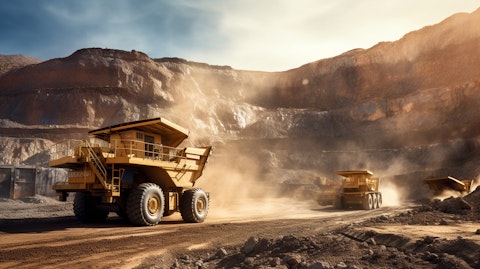McEwen Mining Inc. (NYSE:MUX) Q4 2023 Earnings Call Transcript March 1, 2024
McEwen Mining Inc. isn’t one of the 30 most popular stocks among hedge funds at the end of the third quarter (see the details here).
Operator: Hello, ladies and gentlemen. Welcome to McEwen Mining’s Q4 and Year-End 2023 Operating and Financial Results Conference Call. Present from the company today are Rob McEwen, Chairman and Chief Owner; Perry Ing, Chief Financial Officer; William Shaver, Chief Operating Officer; Stefan Spears, Vice President, Corporate Development; Michael Meding, Vice President and General Manager of McEwen Copper; Jeff Chan, Vice President, Finance; Carmen Diges, General Counsel and Secretary. After the speakers’ presentation, there will be a question-and-answer session. [Operator Instructions] I will now turn the call over to Mr. Rob McEwen, Chief Owner. Please go ahead, sir.
Rob McEwen : Thank you, operator. Good morning, ladies and gentlemen, and welcome. I’m delighted to say we had a great year. Not only did our strategy to surface value of McEwen Copper and a very large copper project, Los Azules, delivered large gains, but also our gold and silver mines increased production and met guidance and reduce their production cost per ounce closer to industry averages. In addition, our exploration efforts delivered solid gains in — at Los Azules and that’s our properties in Timmins. And all of this allowed us to report a net income of $54.7 million or $1.15 per share, versus a net loss of $81.1 million or $1.71 in 2022. These big swings in our bottom line are largely due to our investment in McEwan Copper and its 100% ownership in our massive Los Azules property.
Prior to last October, we own more than 50% of McEwen Copper. And as a result, McEwen Mining’s financials represented the consolidation of its financials with that of McEwen Copper, where we have been spending hundreds of millions of dollars, advancing the Los Azules project first to an updated preliminary economic assessment, which we released in June of last year. And now we’re driving towards completing a bankable feasibility study in the first quarter of 2025. In October of last year, we completed our third financing of McEwen Copper. And as a result of that, our ownership dropped below 50% to 48% and that led to us no longer consolidating the financials of McEwen Copper, and it generated a significant gain, which is reflected in our financials, which was the strategy from the very beginning to surface value for McEwen Mining.
Now the biggest — I think we’re trading at a substantial discount. And I can see a price that –although we’re trading around $6 a share, and it is biased. We have a management view that we’re trading at anywhere between $7 and $29 a share. So I think there’s a lot of room on the upside. And that’s driven by — we have basically three sets of assets and that’s the sum of the parts. We have McEwen Copper, which we own 48% of, we have a royalty portfolio. And we have our gold and silver assets. So we have values ranging from $8 to $30 a share. So I think there’s — you can look at it and say we’re trading at a big discount for where there’s a lot of upside. Now it’s been a hard couple of years for us and shareholders. From September ’18 to the end of August ’22, our share price was going in one direction, and that was not the direction I ever wanted it to go.
And that was down. And I call that the road to hell. Right now, I’ll call it, we’re on the road to redemption. And if we compare our results, and maybe it’s a false cheer. But when you look at how we performed against the price of gold, the price of copper, the NASDAQ, the Dow since September ’22, when we did our first financing in McEwen Copper. McEwen Mining is up 107%, the NASDAQ is up 37%, Silver 27%, the Dow 23%, Gold 20%, GDX 14%, GDXJ up 13% and Copper up 12%. We’re clearly outperforming. I think we have two drivers. One is our copper, which I think is — and have long considered a potential copper unicorn and that we’re seen shape out. And then the second is the turnaround in our gold and silver assets that are delivering positive cash flows and financing our exploration programs there.

And we have some exciting development programs one in Timmins, where we expect to put a ramp down and start production in ’25 on a discovery we made several years ago. Stock West, Stock East. We recently put out some results, some intriguing high grade over there. And the importance of the stock mine, is threefold. One, it’s right beside our mill. So it would eliminate the transportation costs we currently have of about $10 a ton. Two, it doesn’t have a royalty on it. So we’re going to save on that royalty of about $1,500 an ounce that we have to give up. And three, the rock is softer, which means we should be able to process a higher volume of material through the mill and in theory, produce more gold as a result of that and bring down our costs.
At Los Azules, in McEwen Copper, we delivered a very robust preliminary economic assessment in June. We’ve got a project there that I can’t help myself, but I always look at something that’s not gold and try to convert it into gold to try to get a sense of its scale. So when I do that with Los Azules, it’s indicated and inferred resources, you get a resource of 37.6 billion pounds of copper. If you were to take today’s price of gold and divided by the price of copper to find out how many copper pounds equals 1 ounce of gold is about 536 pounds of copper, 1 ounce of gold, divide that into 36.7 billion pounds of copper, and you’re looking at a of gold equivalent deposit of 70 million ounces. The average production of 321 million pounds of copper per annum would translate into about 600,000 ounces a year.
And with a cash cost of $1.07 a pound, the gold equivalent of that would be just under $600 an ounce. By my book, that is a big gold equivalent deposit and reflects the size and I think the power of Los Azules. This is — we’re looking at a 27-year life and I think there’s still quite a bit of room in improving the value of that asset and that improving the value of McEwen Mining. And then you look at the gold and silver assets where we’re doing exploration I’m quite pleased with what we’re getting there. It’s taken a while, but we’re moving in very much the right direction. Our press release outlines pretty well. We have another project in Mexico that we’re looking at advancing later this year. And I want to come back to Los Azules for a moment because what we’re trying to do there is a bit different than what’s in the market right now.
Mining generally is held in poor opinion by most of the world. I feel it’s very damaging to the environment, and it’s not important to life. But I can assure you, if all the mines stopped tomorrow, modern civilization would grind to an abrupt halt. And somehow, we have to put that message out there that we can mine the earth resources in a manner that is viewed as responsible and sensitive to the environment. So at Los Azules, Several years ago, we engaged the services of an architect who is very prominent in the green living building space. And asked him to help us redefine mining to look at it so that we could hopefully move in the direction of shifting the perception of the public perception of mining. And so we’re looking to create the future.
And in order to create the future, it has to look like the future, both in terms of its buildings. We have some wonderful renderings, very comfortable, safe, attractive accommodations for the workforce, but also looking at how do we treat the world. And we’re looking at a project that will have a much lighter impact on the environment, initially emitting one third of CO2 emissions, using less than one quarter of the water of a comparable size, conventional copper mine being powered by 100% renewable energy sourced from hydro water and wind and producing a sustainable copper cathode. Most of the mines, copper mines today in the world produce concentrate that has to be shipped to a smelter, then convert it into a product that is usable by industry.
With our copper cathode, it can go directly to industry and cut out the transportation cost. And we think that will attract a premium in the marketplace as well. So with that, I’d like to open it up for questions.
See also 15 Highest Paying Countries for Chefs and 14 Countries with Low Humidity You Can Retire To.
Q&A Session
Follow Mcewen Mining Inc. (NYSE:MUX)
Follow Mcewen Mining Inc. (NYSE:MUX)
Operator: [Operator Instructions] Your first question will come from the line of Heiko Ihle with H.C. Wainwright. Please go ahead.
Heiko Ihle : Hey. Sorry, I was on mute. Hey, Rob, and team, thanks for taking my questions. Earlier on this call, you talked about the lower production costs. And it’s now officially March or two thirds through Q1 at this point. How much more in these cost savings have you seen in Q1 thus far? And maybe if you could give a bit of a break on where they derive from. I mean, obviously, you have your guidance in the release, but maybe you just want to provide a bit more color raw numbers.
Rob McEwen : I’ll ask Bill to answer that question, Heiko.
William Shaver : Yeah. Thanks for the question, Heiko. I guess the — the drivers of the costs are basically pretty fundamental in terms of labor cost power cost exposures, all of those things that make up the cost. So what we have to do in 2024 and then going forward is we have to produce more ounces in order to drive some of those monthly operating costs down in such a way that we can improve the overall operating cost and also improve, of course, the margin. And so that’s basically the direction that we’re going in. As we transition from mining — from mine over into stock, we’re going from or that has a work index of between ’21 and ’23 to one between, say, ’14 and ’17. So that will allow us to increase the number of tonnes per day going through the plant.
The grades are, for the most part, similar. And so that will allow us to move up the production from the present 50,000 ounces a year up to 60. And I guess, in the longer term, we’re also looking at ways that we can get that tonnage up a little bit higher by adding some capacity to our grinding circuit. So that’s kind of the short term and the longer-term aspirations in terms of getting the operating cost per tonne and per ounce lower.
Heiko Ihle : Yeah. That was good. Thank you. Completely different question. You had a reasonably large flow-through financing in December of last year it was CAD22 million. How much of that have you already spent at Fox this year? And how much — should we just more or less assume that it’s even by quarter?
William Shaver : Yeah. So yeah, of that total amount of money, approximately half of it is or CEE for drilling. And I would say if you divide that by, say, something like 10 or 11 that will be the expenditures per month. The CEE is for development of the infrastructure at stock, and that will get — we’ll start the spending and not I guess, at the beginning of the second quarter. And so — and it will get spent over the rest of the year. So that’s probably something like a little bit over $1 million to $1.2 million a month.
Heiko Ihle : Okay. I’ll get back in queue. Thank you all.
Rob McEwen : Thanks, Heiko.
Operator: Your next question comes from the line of Joseph Reagor with ROTH Capital. Please go ahead.
Joseph Reagor : Hey, Rob and Team.
Rob McEwen : Hey, Joe.
Joseph Reagor : Hey. Thanks for taking my questions. I guess the first one is since you had this large gain in Q4, can you guys just back that out and for apples-to-apples sake, what would the earnings have looked like in Q4?
Rob McEwen : Jeff you.
Jeff Chan: Sure. I’ll take that one. So we reported net income for the year of $54.7 million. I would add back the accounting gain of $224 million less the deferred tax accounting impacts of that of $37 million. So I think once you remove those factors, that would normalize the earnings from that accounting.
Joseph Reagor : Yeah, it’s the taxes I needed there. Thanks for clarifying. Okay. And then as you guys think about 2024, other than issuing the copper, what are the big things you guys are looking at for growth in this year and maybe into next? Is it the Mexican assets? Is it developing stock and drilling that out more? What should we be looking at?
Rob McEwen : Number one would be behind Los Azules would be Timmins and the development of the Stock property, which is serving as the next source of production coming on stream. And there’s quite a bit of exploration going on there. We’ve had a couple of press releases out recently talking about the increase in the resource at stock than the over at Stock East. There’s been some high grade that’s intriguing. And we’re also drilling at over at Grey Fox, where there’s over 1 million ounces. We’re looking at possible additions if we can make it of adjacent areas that would be complementary to our production base. Second would be Mexico.
William Shaver : Yeah. Second would be Mexico. I think we have to complete — well, we have to complete the engineering, but the driver is probably the permitting phase where we hope to have permits sometime middle of this year, but permitting is always a challenge in every part of the world today. So we don’t know exactly where or when that’s going to happen. But that’s part of the future plan. We also have a plan to expand our production at Gold Bar. Gold Bar is an asset where we have a leach pad, as you probably know. And we have — there’s a there’s enough different workplaces at Gold Bar for us to increased production. And last year, we were able to construct our new leach pad. So now we have no constraints in terms of the area where we can put material to be leased.
And so that’s one of the strategies for this year is to increase the ore production at Gold Bar get it onto the pad, and that will result in an increase in total ounces produced at Gold Bar. So I think we’re looking at improving the production at all three operations or the two operations that are running today as well as at as well as in Mexico. So I think that’s our goal this year. And then as we move forward, it’s to do more of that kind of increase and maybe try and get the whole Timmins complex. So it’s producing, say, 25% or 30% better tonnage going into 2025.




